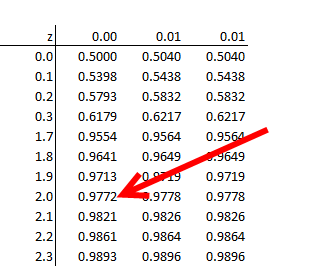You are using an out of date browser. It may not display this or other websites correctly.
You should upgrade or use an alternative browser.
You should upgrade or use an alternative browser.
Level I (Questions 1-20) FRM 2010 Practice Questions – Vol. I
- Thread starter skoh
- Start date
Also could you kindly explain on how to derive the answer for question 17? I was looking through the z-table but I don't understand how to get 0.0228 for 82.5?
Assume that a random variable follows a normal distribution with a mean of 100 and a standard deviation of 17.5.What is the probability that this random variable is between 82.5 and 135?
a) 68.0%
b) 81.9%
c) 82.8%
d) 95.0%
Answer:
Prob (-1*σ < X < 2*σ) = (1 - 0.0228) - 0.1587 = 0.8185
82.5 = 100 - 17.5 and 135 = 100 + 2 * 17.5. So, the percentage is 34% on the left hand side of the mean, plus 95%/2 on the right hand side of the mean.
Assume that a random variable follows a normal distribution with a mean of 100 and a standard deviation of 17.5.What is the probability that this random variable is between 82.5 and 135?
a) 68.0%
b) 81.9%
c) 82.8%
d) 95.0%
Answer:
Prob (-1*σ < X < 2*σ) = (1 - 0.0228) - 0.1587 = 0.8185
82.5 = 100 - 17.5 and 135 = 100 + 2 * 17.5. So, the percentage is 34% on the left hand side of the mean, plus 95%/2 on the right hand side of the mean.
Hi skoh,
1. No, the 2*Δy is used when the prices in the numerator are shocked by +/- Δy. The difference between Price at (y0+Δy) and Price at (y0-Δy) is a price difference due to 2*Δy. This is a totally understandable mistake and why it's helpful to understand that effective duration = slope * -1/P; i.e., it's just a rise/run where you want the price difference (rise) to match the yield difference (run), please see: http://forum.bionicturtle.com/threa...uration-and-general-question.6846/#post-23455
2. I'm not sure why they used (1-0.0228) but it goes to show how we want to be comfortable with normal symmetry. If we want the probability at -2 standard deviations (i.e., 82.5), a lookup table in a stat book might only give us positive Zs (the right-hand side of the standard normal). So we would need to find Pr[Z < 2.0] = 0.9772, see below. That tells us that 97.72% of the standard normal is left of +2.0 Z. We want all of that probability except for the left tail where X < 1 sigma = Pr[Z < -1] = 1 - Pr[Z < +1] = 1 - 0.8413 = 15.87%
i.e., we need to be able to use Pr[Z < +1.0] in the lookup table in order to deduce Pr[Z < -1.0] per symmetry.
so Pr[ -1 < Z < +2] = 97.72% is all area left of +2 minus (-) 15.87% is area left of -1.0 = 81.86%

I hope that helps,
1. No, the 2*Δy is used when the prices in the numerator are shocked by +/- Δy. The difference between Price at (y0+Δy) and Price at (y0-Δy) is a price difference due to 2*Δy. This is a totally understandable mistake and why it's helpful to understand that effective duration = slope * -1/P; i.e., it's just a rise/run where you want the price difference (rise) to match the yield difference (run), please see: http://forum.bionicturtle.com/threa...uration-and-general-question.6846/#post-23455
2. I'm not sure why they used (1-0.0228) but it goes to show how we want to be comfortable with normal symmetry. If we want the probability at -2 standard deviations (i.e., 82.5), a lookup table in a stat book might only give us positive Zs (the right-hand side of the standard normal). So we would need to find Pr[Z < 2.0] = 0.9772, see below. That tells us that 97.72% of the standard normal is left of +2.0 Z. We want all of that probability except for the left tail where X < 1 sigma = Pr[Z < -1] = 1 - Pr[Z < +1] = 1 - 0.8413 = 15.87%
i.e., we need to be able to use Pr[Z < +1.0] in the lookup table in order to deduce Pr[Z < -1.0] per symmetry.
so Pr[ -1 < Z < +2] = 97.72% is all area left of +2 minus (-) 15.87% is area left of -1.0 = 81.86%

I hope that helps,
Similar threads
- Sticky
- Replies
- 6
- Views
- 1K
- Replies
- 1
- Views
- 272
- Replies
- 19
- Views
- 2K
